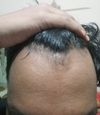community How long is minoxidil generally effective for if taken alongside finasteride? Forever?
Minoxidil does not maintain efficacy indefinitely when used alone, but its effectiveness may be prolonged when used with finasteride. Finasteride can maintain some degree of efficacy indefinitely.

